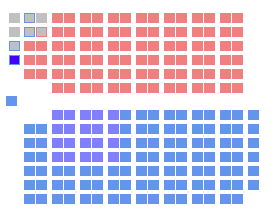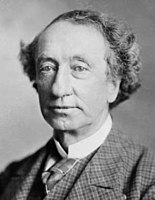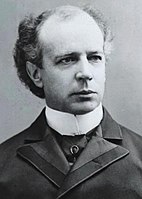1891 Canadian federal election
| |||||||||||||||||||||||||||||||||||||
215 seats in the House of Commons 108 seats needed for a majority | |||||||||||||||||||||||||||||||||||||
|---|---|---|---|---|---|---|---|---|---|---|---|---|---|---|---|---|---|---|---|---|---|---|---|---|---|---|---|---|---|---|---|---|---|---|---|---|---|
| Turnout | 64.4%[1] ( | ||||||||||||||||||||||||||||||||||||
| |||||||||||||||||||||||||||||||||||||
 1891 Canadian electoral map | |||||||||||||||||||||||||||||||||||||
 The Canadian parliament after the 1891 election | |||||||||||||||||||||||||||||||||||||
| |||||||||||||||||||||||||||||||||||||
The 1891 Canadian federal election was held on March 5, 1891, to elect members of the House of Commons of Canada of the 7th Parliament of Canada. It was won by the Conservative Party of Prime Minister Sir John A. Macdonald.

The main issue of the 1891 campaign was Macdonald's National Policy, a policy of protective tariffs. The Liberals supported reciprocity (free trade) with the United States. Canadian voters would return to the issue of free trade 20 years later in the 1911 federal election.
Macdonald led a Conservative campaign emphasizing stability, and retained the Conservatives' majority in the House of Commons. It was a close election and he campaigned hard. Macdonald died a few months after the election, which led to his succession by four different Conservative Prime Ministers until the 1896 election.
It was Wilfrid Laurier's first election as leader of the Liberals. Although he lost the election, he increased the Liberals' support. He returned in 1896 to win a solid majority, despite losing the popular vote.
The Nationalist Party won a seat in Quebec. Dorchester riding elected Cyrille-Émile Vaillancourt.[2]
National results
[edit]
| Party | Party leader | # of candidates | Seats | Popular vote | |||||
|---|---|---|---|---|---|---|---|---|---|
| 1887 | Elected | Change | # | % | Change | ||||
| Conservative | John A. Macdonald | 187 | 87 | 97 | +11.5% | 332,961 | 42.96% | +2.80pp | |
| Liberal-Conservative | 25 | 24 | 20 | -16.7% | 43,557 | 5.62% | -1.64pp | ||
| Liberal | Wilfrid Laurier | 194 | 79 | 90 | +13.9% | 350,512 | 45.22% | +2.09pp | |
| Independent Conservative | 4 | 3 | 3 | - | 15,045 | 1.94% | +0.38pp | ||
| Independent | 4 | 3 | 2 | -66.7% | 6,357 | 0.82% | -0.42pp | ||
| Nationalist | 1 | 1 | 1 | - | -1 | 0.00% | -0.66pp | ||
| Independent Liberal | 2 | 5 | 1 | -80% | 5,573 | 0.72% | -1.45pp | ||
| Nationalist Conservative | 1 | 2 | 1 | -50% | 1,271 | 0.16% | -0.32pp | ||
| Unknown | 14 | 1 | - | -100% | 16,890 | 2.18% | -1.15pp | ||
| Equal Rights | 2 | * | - | * | 2,455 | 0.32% | * | ||
| Progressive2 | 2 | * | - | * | 468 | 0.06% | * | ||
| Total | 436 | 205 | 215 | +4.9% | 775,089 | 100% | |||
| Sources: http://www.elections.ca -- History of Federal Ridings since 1867 | |||||||||
Notes:
* Party did not nominate candidates in the previous election.
1 One Nationalist candidate was elected by acclamation.
2 The Parliamentary website identifies two candidates in Nova Scotia as being "Progressives". This may be an error.
Acclamations:
The following Members of Parliament were elected by acclamation;
- British Columbia: 1 Conservative, 1 Liberal-Conservative
- Manitoba: 1 Conservative
- Ontario: 1 Conservative
- Quebec: 1 Conservative, 2 Liberal, 1 Nationalist
Results by province
[edit]| Party name | BC | NWT | MB | ON | QC | NB | NS | PE | Total | ||
|---|---|---|---|---|---|---|---|---|---|---|---|
| Conservative | Seats: | 5 | 4 | 1 | 39 | 24 | 10 | 12 | 2 | 97 | |
| Popular vote (%): | 71.6 | 81.0 | 12.6 | 42.2 | 45.4 | 48.9 | 41.9 | 48.5 | 43.0 | ||
| Liberal-Conservative | Seats: | 1 | 3 | 7 | 3 | 2 | 4 | 20 | |||
| Vote (%): | 40.5 | 5.3 | 3.0 | 3.7 | 10.8 | 5.6 | |||||
| Liberal | Seats: | - | - | 1 | 44 | 33 | 4 | 5 | 3 | 90 | |
| Vote (%): | 28.4 | 19.0 | 46.9 | 49.1 | 45.9 | 41.3 | 43.6 | 41.0 | 45.2 | ||
| Independent Conservative | Seats: | 1 | 2 | 3 | |||||||
| Vote (%): | 1.3 | 5.9 | 1.9 | ||||||||
| Independent | Seats: | 1 | 1 | - | 2 | ||||||
| Vote (%): | 0.7 | 1.2 | 3.2 | 0.8 | |||||||
| Nationalist | Seats: | 1 | 1 | ||||||||
| Vote (%): | - | - | |||||||||
| Independent Liberal | Seats: | - | 1 | 1 | |||||||
| Vote (%): | 2.9 | 10.5 | 0.7 | ||||||||
| Nationalist Conservative | Seats: | 1 | 1 | ||||||||
| Vote (%): | 0.7 | 0.2 | |||||||||
| Total seats | 6 | 4 | 5 | 92 | 65 | 16 | 21 | 6 | 215 | ||
| Parties that won no seats: | |||||||||||
| Unknown | Vote (%): | 2.0 | 3.8 | 3.1 | 2.2 | ||||||
| Equal Rights | Vote (%): | 0.7 | 0.3 | ||||||||
| Progressive | Vote (%): | 0.5 | 0.1 | ||||||||
See also
[edit]- List of Canadian federal general elections
- List of political parties in Canada
- 7th Canadian Parliament
Notes
[edit]- ^ Popular vote is combination of Conservative and Liberal-Conservative tallies.
- ^ Laurier also ran in Richmond—Wolfe, where he was defeated.
References
[edit]- ^ "Voter Turnout at Federal Elections and Referendums". Elections Canada. Retrieved March 10, 2019.
- ^ https://lop.parl.ca/sites/ParlInfo/default/en_CA/People/Profile?personId=6267
Further reading
[edit]- Pennington, Christopher John (2011). The Destiny of Canada: Macdonald, Laurier, and the Election of 1891. Toronto: Allen Lane Canada. ISBN 978-0-670-06621-6.


 French
French Deutsch
Deutsch
